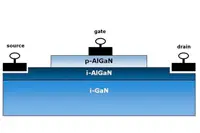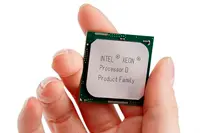Electronics News
Archive : 10 March 2015 год
 The performance of devices such as mobile phone cameras and solar cells could be boosted by 'nano earthquakes', according to researchers from Australia's RMIT University.
The performance of devices such as mobile phone cameras and solar cells could be boosted by 'nano earthquakes', according to researchers from Australia's RMIT University.
The performance of devices such as mobile phone cameras and solar cells could be boosted by 'nano earthquakes', according to researchers from Australia's RMIT University.
In a study led by Dr Sharath Sriram, Drs Sumeet Walia, pictured left, and Amgad Rezk have examined the use of sound waves to change the electronic properties of 2D materials. The researchers say their findings have important implications for electronics and optoelectronic devices made from 2D materials and believe their work could herald a new era of highly efficient solar cells and smart windows.
The RMIT research looked at ways of using surface acoustic waves – what the team calls nano earthquakes – to control the properties of 2D materials.
"Sound waves can be likened to ripples created on the surface of water, but where we can control the direction and intensity of these ripples," Dr Walia said. "In this work, we use these ripples which occur on a crystal surface and couple them into a material that is a few atomic layers thick. This causes a change in its electronic properties.
"As the surface acoustic waves are turned on and off or increased and decreased in intensity, the change in electronic properties of the 2D materials follows the same pattern."
Dr Rezk added: "We have found [these waves] under the surface of the 2D materials drag electrons along their path, tuning the amount of light emitted by the material. Remarkably, the acoustic wave based tunability did not result in any structural or compositional change in the material.
"As soon as the acoustic waves were removed, the material retracted back to its initial optical state and therefore this mechanism is highly adaptable for a variety of dynamically operating systems."
Author
Graham Pitcher
Source: www.newelectronics.co.uk
 NXP is to acquire Freescale in a deal which values the latter at $17.6billion. The merged company will become the leading supplier of semiconductors to the automotive sector, the market leader in general purpose microcontrollers and the fourth largest semiconductor supplier, excluding memory companies.
NXP is to acquire Freescale in a deal which values the latter at $17.6billion. The merged company will become the leading supplier of semiconductors to the automotive sector, the market leader in general purpose microcontrollers and the fourth largest semiconductor supplier, excluding memory companies.
"This is a transformative step in our objective to become the industry leader in high performance mixed signal solutions," said NXP's president and CEO Rick Clemmer, pictured, who will hold both positions post merger. "The combination of NXP and Freescale creates an industry powerhouse focused on the high growth opportunities in the smarter world."
"Both companies have built leadership positions and have a sharp focus on delivering superior value to customers," added Gregg Lowe, Freescale's president and CEO. "Our combined scale, size and global reach will position our new company to deliver sustainable above market growth. It will also serve to accelerate the strategic plans in which both companies have invested, enabling us to deliver more complete solutions to customers."
Both companies have a similar history. Both were acquired by private investors within months of each other in 2006. Both suffered more than a bit of pain as the investors loaded their balance sheets with debt just as demand for semiconductors slumped. It has been a long road back for the two companies, both of which had been considered as being in 'intensive care' for a while.
With the bad times apparently behind them – but with the acknowledgement that Freescale is still carrying close to $5bn of debt – both companies are looking to a better future. The question is, of course, will combining forces take them to that better future?
One of the reasons for the merger – that's what it's being called – is the decline in the long term growth rates for the semiconductor industry. Once, companies would be disappointed if sales grew by less than 15% a year; today, that's more like 5%. Clemmer, talking to an audience of analysts on a conference call, claimed the merged company would grow revenues by '1.5 times the market'. But belts are being added to braces with the stated aim to reduce costs by $500million. How that will be done has yet to be decided, but NXP's chief financial officer Peter Kelly pointed to 'synergies' in administrative and support operations, as well as the ability of the larger company to cut better deals with its suppliers – which may well be a message to its foundry partners.
One of the reasons given by Clemmer for why the deal will succeed is that both companies have broadly complementary product portfolios. However, it will be interesting to see how the microcontroller line ups shake out as both companies offer broadly similar ranges of ARM Cortex based devices.
Whoever ends up being the sales director for the new organisation will be pushing two themes: 'solutions' and 'cross selling'. Clemmer said: "Within the automotive sector, the new company will be able to address a wider set of solutions. In the short term, we'll benefit from the increasing semiconductor content in automotive. In the longer term, we'll be positioned to become the thought leader in automotive systems."
Cross selling opportunities will come from a complementary approach to markets like the Internet of Things – known by Freescale as the 'Internet of Tomorrow' and by NXP as 'secure connections for a secure world'.
Here, Clemmer asserted that NXP's security expertise and Freescale's MCU portfolio would provide leading IoT solutions, particularly automotive security.
But will putting two similar companies together bring the growth for which Clemmer is looking? Time will tell, as they say. However, Renesas' experience of integrating NEC Electronics – another similar company – might give all concerned pause for thought.
Author
Graham Pitcher
Source: www.newelectronics.co.uk
 Freescale used embedded world to launch the Kinetis KV5x MCU family, targeted at digital motor control. Geoff Lees, pictured, general manager of Freescale's MCU business, said: "The Cortex-M7 provides the opportunity for a significant step in performance. While the M4 core is already competent for motor control, M7 cores takes that further."
Freescale used embedded world to launch the Kinetis KV5x MCU family, targeted at digital motor control. Geoff Lees, pictured, general manager of Freescale's MCU business, said: "The Cortex-M7 provides the opportunity for a significant step in performance. While the M4 core is already competent for motor control, M7 cores takes that further."
The KV5x family blend the M7's processing power with analogue and timing peripherals and new connectivity, security and safety features. Running at 240MHz, KV5x MCUs have up to 1Mbyte of on chip flash, 128kbyte of data memory and 64kbyte of instruction memory. Also integrated are four 12bit A/D converters, each capable of 5Msample/s, and an IEEE1588 Ethernet controller. According to Freescale, the KV5x family can support fully asynchronous dual three phase motor control.
Freescale also announced volume availability of the i.MX 6SoloX applications processor. With Cortex-M4 and Cortex-A9 cores, i.MX 6SoloX is suited to display centric automotive applications, but also supports home automation, building control and healthcare applications.
Lees also said Freescale is looking at using ST's 28nm FDSOI process in the future. "Leakage could be up to 25 times less," he claimed. "We can get to our targets more effectively using a 28nm process than we could at 40nm or 65nm."
The Embedded Microprocessor Benchmark Consortium (EEMBC) launched the CoreMark-Pro benchmark, which tests processors using five integer workloads and four floating point workloads.
Express Logic announced plans to join ARM's mbed ecosystem. Michael May, vp of marketing, said mbed will need a more robust RTOS and TCP/IP stack as things get more complex, adding ThreadX RTOS and NetX Duo IPv6 network stack will complement the mbed OS.
congatec unveiled the PA-3 single board computer. Based on Intel's Atom E3800 processor, the pico ITX form factor board is aimed at demanding industrial applications.
NXP announced the LPC18Sxx and 43Sxx MCU families. The company says both ranges are suited for any connected application where large volumes of data are handled. The LPC18Sxx range features a Cortex-M3, whilst the 43Sxx family integrates Cortex-M4 and Cortex-M0 cores.
Spansion announced a RAM device featuring its 12pin HyperBus interface. Targeted at SoC and MCU applications, HyperRAM devices have a read throughput up to 333Mbyte/s and come in an 8 x 6mm 25ball BGA.
Marcel Kuba, director of field applications engineering, said the device would be targeted at automotive apps and has been designed for use in temperatures of up to 105°C.
Microchip launched the MM7150 Motion Module, which combines its SSC7150 motion coprocessor with nine axis sensors, including accelerometer, magnetometer and gyroscope. Connecting with a host MCU via I2C, the module is self calibrating and suited for applications ranging from industrial automation to wearable devices.
Following its launch last year of MIPS M class MCU cores, Imagination Technologies said parts based on the core will be launched in late 2015 or early 2016. With hardware virtualisation and hypervisor functionality, the M core is said to suit IoT security and safety critical applications, including automotive.
Microsemi unveiled a reference design that uses the security features of its SmartFusion2 SoC FPGAs and IGLOO2 FPGAs and Escrypt's CycurKEYS cloud based Certificate Authority. It allows customers to integrate Public Key Infrastructure functionality into systems targeted at automotive, industrial, embedded and cyber physical systems.
Altium announced Designer 15.1, with several features for improved design productivity, documentation outputs and high speed design efficiency. Building on design productivity and efficiency, Designer 15.1 adds improved support for xSignals, expanded rigid-flex support, new output documentation options and new design reuse features.
Author
Graham Pitcher
Source: www.newelectronics.co.uk
 This year's embedded world in Nuremberg was dominated, as was to be expected, by the Internet of Things. But the show also saw a growing acceptance that security, as an issue, needed to be taken far more seriously.
This year's embedded world in Nuremberg was dominated, as was to be expected, by the Internet of Things. But the show also saw a growing acceptance that security, as an issue, needed to be taken far more seriously.
Robert Day, vp of sales and marketing, Lynx Software Technologies agreed. "There has certainly been a tendency for security to be seen as an afterthought; a 'bolt on' to embedded designs. The next generation of connected embedded systems will need to have enhanced security, especially when controlling critical infrastructure."
Lynx therefore took the opportunity to announce that its LynxOS 7.0 RTOS and LynxSecure separation kernel hypervisor were moving to new ARM based processors, which would see military grade security applied to the protection of ARM based embedded designs addressing IoT markets.
According to Lynx, its LynxOS 7.0 will be migrated initially to the ARM Cortex-A series of processor cores, enabling designers to use features such as access control lists, audit, quotas, local trusted path, account management, and OpenPAM to enhance improved levels of security.
These capabilities mean security can be designed into a connected embedded device, rather than being added as an afterthought. As a result IoT edge and gateway devices can be deemed 'secure by design', according to Lynx.
The company also announced the LynxSecure separation kernel hypervisor. This provides strict isolation on a single hardware platform, separating memory, CPU and devices without the need of a 'helper' operating system, commonly found in hypervisors.
Building on the security theme, ARM launched the ARM mbed IoT Starter Kit – Ethernet Edition to channel data from Internet connected devices directly into IBM's Bluemix cloud platform. By combining ARM's secure sensor environment with cloud-based analytics, mobile and application resources from IBM faster prototyping of new smart products and value-added services was promised.
According to Krisztian Flautner, general manager of ARM's IoT business: "By securely embedding intelligence and connectivity into devices from the outset, we will be able to create cloud-connected products that are far more capable than today."
Elsewhere, Altera announced a collaboration with Mentor Graphics to provide developers with access to Vista virtual platforms that support Altera's SoC FPGA portfolio, including its 14nm Stratix 10 SoCs, which feature a 64bit quad core ARM Cortex-A53 processor. These advanced SoC virtual platforms are intended to accelerate embedded software development across the entire product life cycle.
"Virtual prototyping is a proven methodology for software development and providing customers with a comprehensive set of SoC virtual platforms will help reduce their development time while cutting development costs," explained Joerg Bertholdt, Altera's director of embedded software marketing.
LDRA revealed that it was collaborating with Texas Instruments to provide automated unit testing capabilities as part of TI's new SafeTI Compliance Support Packages for TI's Hercules MCU software components.
SafeTI CSPs will help TI customers to comply with functional safety standards and reduce verification and validation efforts.
Cortus, a specialist in low power, silicon efficient, 32bit processor IP, was able to unveil three new software partners, enabling its APS architecture to be used in a broader range of embedded and Internet of Things applications.
The ports include a dual IPv4/v6 stack from Oryx Embedded, secure point to point connection software from Nabto and an IDE and real time operating system from Blunk Microsystems.
"For a company like Cortus, it's great to see a growing number of embedded software vendors supporting our APS architecture," said Roddy Urquhart, vice president of sales and marketing. "These ports, along with the recently announced port of Micrium uC/OSIII, offer Cortus licensees a broadening range of capabilities for connected intelligent devices and an enhanced choice of IDE, middleware and RTOS."
Author
Neil Tyler
Source: www.newelectronics.co.uk
 Panasonic has licensed its normally-off GaN transistor structure to Infineon, which will supply the power switches in its SMD packages. The agreement will enable each company to manufacture GaN devices, with customers having two sources for compatible packaged GaN power products. Both will showcase samples of a 600V 70m? device in a dual small outline package at the forthcoming Applied Power Electronics Conference and Exposition.
Panasonic has licensed its normally-off GaN transistor structure to Infineon, which will supply the power switches in its SMD packages. The agreement will enable each company to manufacture GaN devices, with customers having two sources for compatible packaged GaN power products. Both will showcase samples of a 600V 70m? device in a dual small outline package at the forthcoming Applied Power Electronics Conference and Exposition.
"We are convinced that enhancement mode GaN on silicon switches, together with our corresponding driver and optimised driving scheme, will provide high value to our customers, while the dual sourcing concept will help them manage and stabilise their supply chains," said Andreas Urschitz, president of Infineon's Power Management and Multimarket Division.
Toru Nishida, president of Panasonic Semiconductor Solutions, said the move is expected to expand the range of GaN power devices available. "We will continuously contribute to solutions for consumer requests by innovating our normally off GaN technology," he added.
Author
Graham Pitcher
Source: www.newelectronics.co.uk
 Intel has released the Xeon processor D family, its first SoC featuring the Xeon. Built on Intel's 14nm process technology, the D family is said to combine the performance and intelligence of Xeon processors with the size and power savings of an SoC.
Intel has released the Xeon processor D family, its first SoC featuring the Xeon. Built on Intel's 14nm process technology, the D family is said to combine the performance and intelligence of Xeon processors with the size and power savings of an SoC.
"The growth of connected devices and demand for more digital services has created new opportunities for information and communication technology," said Diane Bryant, general manager of Intel's Data Center Group. "By bringing Xeon processor performance to a low power SoC, we're delivering the best of both worlds and enabling our customers to deliver exciting new services."
Intel says the device is the third generation of 64bit SoCs for microserver and associated applications. It claims up to 3.4 times the performance per node, compared to its Atom based second generation 64bit SoC and 1.7 times better performance per Watt.
Two SoCs are available initially: the 2GHz D-1540, with eight dual threaded cores; and the 2.2GHz quad D-1520, with four dual threaded cores. Both consume 45W and feature dual integrated 10GbE, as well as 24 PCIe 3 lanes, eight PCIe 2 lanes and four USB ports. With up to 12Mbyte of L3 cache, both SoCs can address up to 128Gbyte.
There are more than 50 systems currently in design, says Intel, with approximately 75% targeted at network, storage and IoT applications.
Author
Graham Pitcher
Source: www.newelectronics.co.uk

